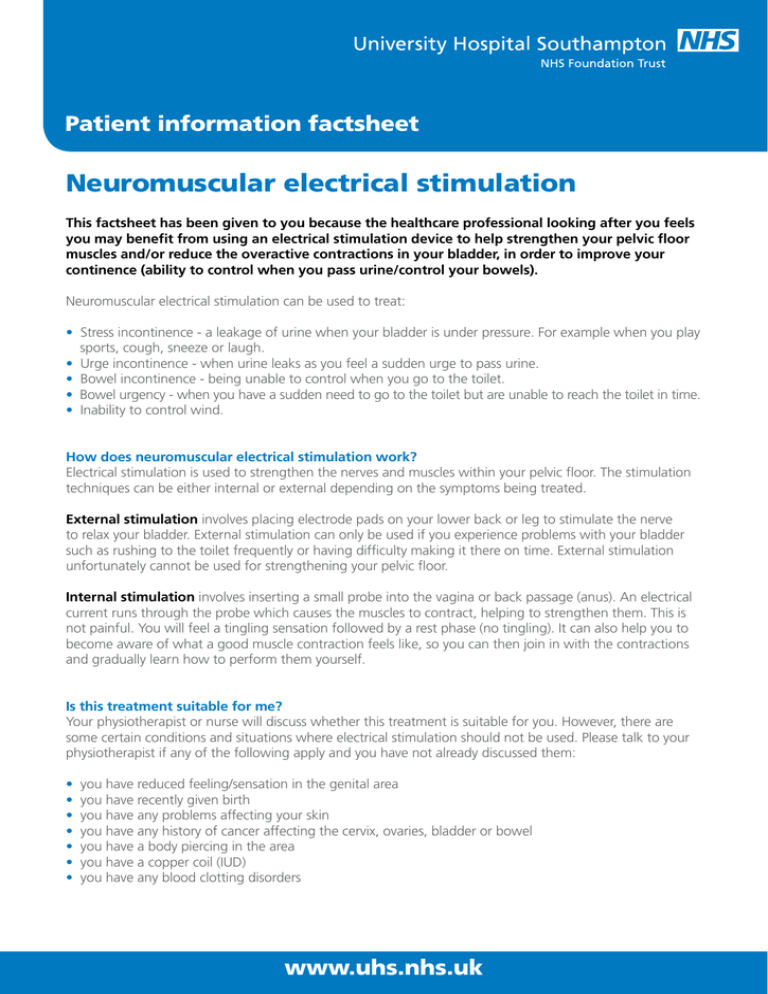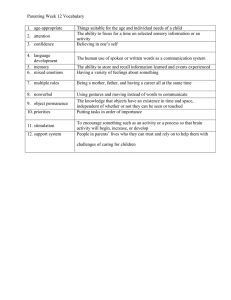
Patient information factsheet
Neuromuscular electrical stimulation
This factsheet has been given to you because the healthcare professional looking after you feels
you may benefit from using an electrical stimulation device to help strengthen your pelvic floor
muscles and/or reduce the overactive contractions in your bladder, in order to improve your
continence (ability to control when you pass urine/control your bowels).
Neuromuscular electrical stimulation can be used to treat:
• Stress incontinence - a leakage of urine when your bladder is under pressure. For example when you play
sports, cough, sneeze or laugh.
• Urge incontinence - when urine leaks as you feel a sudden urge to pass urine.
• Bowel incontinence - being unable to control when you go to the toilet.
• Bowel urgency - when you have a sudden need to go to the toilet but are unable to reach the toilet in time.
• Inability to control wind.
How does neuromuscular electrical stimulation work?
Electrical stimulation is used to strengthen the nerves and muscles within your pelvic floor. The stimulation
techniques can be either internal or external depending on the symptoms being treated.
External stimulation involves placing electrode pads on your lower back or leg to stimulate the nerve
to relax your bladder. External stimulation can only be used if you experience problems with your bladder
such as rushing to the toilet frequently or having difficulty making it there on time. External stimulation
unfortunately cannot be used for strengthening your pelvic floor.
Internal stimulation involves inserting a small probe into the vagina or back passage (anus). An electrical
current runs through the probe which causes the muscles to contract, helping to strengthen them. This is
not painful. You will feel a tingling sensation followed by a rest phase (no tingling). It can also help you to
become aware of what a good muscle contraction feels like, so you can then join in with the contractions
and gradually learn how to perform them yourself.
Is this treatment suitable for me?
Your physiotherapist or nurse will discuss whether this treatment is suitable for you. However, there are
some certain conditions and situations where electrical stimulation should not be used. Please talk to your
physiotherapist if any of the following apply and you have not already discussed them:
•
•
•
•
•
•
•
you have reduced feeling/sensation in the genital area
you have recently given birth
you have any problems affecting your skin
you have any history of cancer affecting the cervix, ovaries, bladder or bowel
you have a body piercing in the area
you have a copper coil (IUD)
you have any blood clotting disorders
www.uhs.nhs.uk
Patient information factsheet
Neuromuscular electrical stimulation should not be used if:
•
•
•
•
•
•
you are or may be pregnant
you have a cardiac pacemaker
there is any infection or tissue damage
you have had recent surgery to area (less than 12 weeks ago)
you have your period
you have epilepsy
Using neuromuscular electrical stimulation at home
If neuromuscular electrical stimulation is appropriate for you, you will be lent a small electrical stimulation
unit to use at home, initially for a six week period. You would use the device for 20 minutes, once or twice
a day as instructed by your physiotherapist. After six weeks your progress will be assessed, and depending
on the level of improvement you may continue using the device for another six weeks or return the device
and carry on doing pelvic floor exercises as advised by your physiotherapist.
Cost
The loan of the device is free of charge, but you will need to sign a consent form and provide your bank
details. No money will be taken from your account and they will be kept locked in a safe place and
returned to you once the device is returned to us.
If you do not return the device and we are unable to contact you, you will however be charged £54.95.
Who to contact if you have any further questions or would like more information
Physiotherapy Department
G level, Princess Anne Hospital
Coxford Road
Southampton
SO16 6YD
Telephone: 023 8120 8967
Useful contacts
NHS Choices – Living with incontinence
www.nhs.uk/livewell/incontinence/Pages/Incontinencehome.aspx
Bladder and bowel foundation
www.bladderandbowelfoundation.org
If you need a translation of this document, an interpreter
or a version in large print, Braille or on audio tape, please
telephone 023 8120 4688 for help.
© 2015 University Hospital Southampton NHS Foundation Trust. All rights reserved. Not to be reproduced in whole or in part without the permission of the copyright holder.
Version 1. Published October 2015. Due for review October 2018. 2015-1066
www.uhs.nhs.uk







